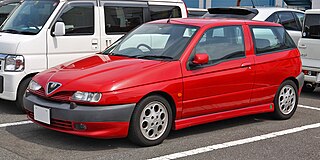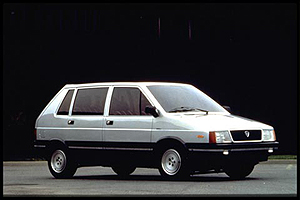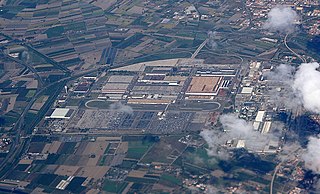
The Fiat Tipo is a compact car, designed by the I.DE.A Institute design house, and produced by the Italian manufacturer Fiat between 1988 and 1995.

Zagato is a coachbuilding company. The design centre of the company is located in Terrazzano, a small village near Rho, Lombardy, Italy. The company's premises occupies an area of 23,000 square metres.

Front-wheel drive (FWD) is a form of engine and transmission layout used in motor vehicles, where the engine drives the front wheels only. Most modern front-wheel drive vehicles feature a transverse engine, rather than the conventional longitudinal engine arrangement generally found in rear-wheel drive and four-wheel drive vehicles.

The Lancia Thema is an executive car produced by the Italian automaker Lancia between 1984 and 1994, and one of four cars to share the Type Four platform alongside the Alfa Romeo 164, Fiat Croma and Saab 9000. The Thema was first shown in Turin Motor Show in 1984.

The Alfa Romeo 164 is a four-door executive saloon manufactured and marketed by Italian automaker Alfa Romeo from 1987-1998, styled by Pininfarina, and cooperatively designed and sharing platforms and numerous elements with the Fiat Croma, Saab 9000 and Lancia Thema.

The Alfa Romeo 155 is a compact executive car produced by Italian automobile manufacturer Alfa Romeo between 1992 and 1998. It was unveiled in January 1992 at Barcelona, with the first public launch in March 1992, at the Geneva Motor Show. A total of 195,526 units were made before it was replaced by the 156.

The Type Four chassis was a shared front wheel drive platform used in the 1980s and 1990s for the Saab 9000, Fiat Croma, Lancia Thema and Alfa Romeo 164.
The Premium platform was General Motors's and Fiat Group's high-end automobile platform for front wheel drive and four wheel drive automobiles developed in early 2000s mainly in Sweden by Saab engineers.

The Alfa Romeo 145 and the Alfa Romeo 146 are small family cars produced by Italian automobile manufacturer Alfa Romeo between 1994 and 2000. The 145 is a three-door hatchback and was launched at the 1994 Turin Motor Show, while the 146 is a five-door hatchback, launched in 1995 to replace the Alfa Romeo 33.
Multijet is Fiat Chrysler Automobiles' term for its current common rail direct injection turbodiesel engine range. Most of the Fiat, Alfa Romeo, Lancia range as well as certain Chrysler, RAM Trucks, Jeep and Maserati vehicles are equipped with Multijet engines. Ownership of some Fiat Multijet designs is shared with General Motors as part of a settlement of the failed merger between the two auto conglomerates. GM Powertrain Torino group in Turin, Italy manages their interest in these engines. Some PSA Peugeot Citroën diesel engines are also rebadged JTD units, and vice versa. Fiat's common rail diesel engine is also known as JTD, an initialism of Jet Turbo Diesel.
The ZF 4HP18 is a four-speed automatic transmission for passenger cars from ZF Friedrichshafen AG. Introduced in 1987, and produced through 1998, it was used in a variety of cars from Alfa Romeo, Audi, Citroën, Dodge, Eagle, Fiat, Lancia, and Saab.

Blue&Me is an integrated in-vehicle infotainment system used worldwide on many vehicles marketed by Fiat Chrysler Automobiles (FCA) from model years 2006–2017. With the exception of the Ford Ka, which is a lightly modified Fiat 500, the system is exclusive to Abarth, Alfa Romeo, Fiat and Lancia cars and to Fiat Professional's light commercial vehicles

The Lancia Megagamma is a small, almost one-box, concept MPV, designed by Italdesign and introduced at the 1978 Turin Motor Show. In retrospect the Megagamma was more influential on later designs than it was itself successful, becoming the "conceptual birth mother of the MPV/minivan movement."
The Fiat C-platform was an automobile platform used in small family cars of the Fiat Group. The predecessors of the C-platform were the Type Three and Type Two platforms, and the successor is the new Compact platform which debuted in Alfa Romeo Giulietta in 2010.

The Alfa Romeo Pomigliano d'Arco plant, commonly called simply Stellantis Pomigliano, is an automotive assembly plant now owned by Stellantis, officially known as the Giambattista Vico Plant since 2008, in memory of the Neapolitan philosopher. The plant, originally designed and constructed in 1968 by Alfa Romeo, is located largely in the town of Pomigliano d'Arco, and partially in the town of Acerra, employing roughly 6,000.

The Compact platform was developed by engineers of the Fiat group for the construction of small family cars and large family cars with front-wheel drive or four-wheel drive. The first incarnation of this platform was the Alfa Romeo Giulietta which was unveiled in 2010. Fiat has invested 100 million euros into the construction of the Compact Platform.

The SCCS platform, also called Small Platform or 199 platform is an automobile platform originally developed by Fiat for subcompact, front-wheel drive, and all-wheel drive vehicles. It was first used on the Fiat Grande Punto, which was unveiled in 2005. Developed during the GM-Fiat alliance, the platform was also used for some Opel models including the Opel Corsa D and E. A derivative called the Small Wide platform was introduced in 2012 for applications on larger cars in the compact segment. Usage of the platform continued through the merger of Fiat and Chrysler which created Fiat Chrysler Automobiles (FCA), and the merger of FCA and PSA which formed Stellantis.

The Type Two platform was a front wheel drive platform designed by the Italian Fiat Group and used during the late 1980s, 1990s and early 2000s for a range of Alfa Romeo, Fiat and Lancia models. It introduced the concept of a "modular" platform, albeit not as modular as current platforms are, allowing the group to assemble various models, also with some special modifications, from the same floorpan. It uses four-wheel independent suspension, composed of MacPherson struts at the front and trailing arms at the rear, with Alfa Romeo Spider and GTV using a multilink setup rather than trailing arms.
The FCA Giorgio Platform is an automobile platform made by Fiat Chrysler Automobiles since 2015 debuting in the Alfa Romeo Giulia. Following the merger with Groupe PSA to form Stellantis in 2021, the platform is anticipated to be phased out due to its inability to accommodate either hybrid plug-in or electric power plants, and will be replaced with the newer Giorgio Evo/STLA Large EV platform.
Sergio Limone is an Italian automobile engineer. He has carried out numerous sports car projects for the Fiat Group, including the Lancia Rally 037, Lancia Delta S4 and Lancia Delta for FIA World Rally Championship, and the Alfa Romeo 155 and Alfa Romeo 156 Touring cars.













